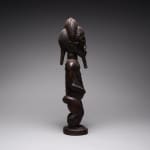Baule Wooden Blolo Bian Sculpture, 20th Century CE
Wood
43.8 x 8.9 cm
17 1/4 x 3 1/2 in
17 1/4 x 3 1/2 in
PF.3627
Further images
This standing male figure was probably carved to represent 'the other world man' (Blolo Blian) of a Baule woman. Such figures are carved at the recommendation of a diviner for...
This standing male figure was probably carved to represent "the other world man" (Blolo Blian) of a Baule woman. Such figures are carved at the recommendation of a diviner for both men and women to resolve crises associated with marriage, sexuality or social well being (Vogel, 1977). The figure becomes a stand-in for the other world (Blolo) mate who has a one-to one relationship with the person who lives "here on this earth" (Asie'n Suwa). Offerings presented to the sculpture formally symbolize recognition and acknowledgment (Vogel 1980; Ravenhill 1984).
The Baule consider the other world to be equivalent to the visible world, and it's inhabitants to have the same form as their real world partners. Hence Blolo figures are carved as idealizations of human beauty. Great emphasis is placed on the beauty of a well-delineated face, elaborate and carefully rendered coiffure, and beauty scarification (Vogel, 1988). Otherworldly figures frequently bear symbols of power, both social and magical: the long twisted beard is a symbol of veneration. In use, the figure would have been properly dressed: he would have worn a miniature cloth “cache-sexe” suspended from a beaded or corded waistband and passed through the cavity below the genital area. In the privacy of the owner's bedroom, the figure would have been a constant reminder of the ongoing presence of the "other man" in the "other world" whom she could not neglect.
The Baule consider the other world to be equivalent to the visible world, and it's inhabitants to have the same form as their real world partners. Hence Blolo figures are carved as idealizations of human beauty. Great emphasis is placed on the beauty of a well-delineated face, elaborate and carefully rendered coiffure, and beauty scarification (Vogel, 1988). Otherworldly figures frequently bear symbols of power, both social and magical: the long twisted beard is a symbol of veneration. In use, the figure would have been properly dressed: he would have worn a miniature cloth “cache-sexe” suspended from a beaded or corded waistband and passed through the cavity below the genital area. In the privacy of the owner's bedroom, the figure would have been a constant reminder of the ongoing presence of the "other man" in the "other world" whom she could not neglect.







